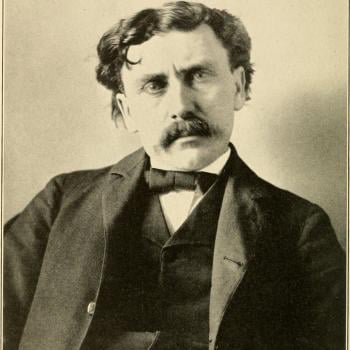I have been involved in a project on the early church, around the year 200 AD. My first basic question concerns the issue of numbers, and the results offer some surprises.
Just how many Christians were there in 200? Around 197, Tertullian’s Apology made extravagant claims for the scale of Christian numbers. He spoke of “the immense number of Christians … almost all the inhabitants of your various cities being followers of Christ.” His numerical claims for the overall number of Christians are ludicrous, but his statement points to the extreme concentration of Christian numbers in some centers.
Estimating Christian numbers at any point in history (even today) is a difficult task. For the early church, the classic figures come from my Baylor colleague Rodney Stark in his 1996 book The Rise of Christianity. This made an excellent attempt at providing some kind of general parameters. Drawing analogies with modern new religious movements, Stark showed that Christians could have achieved their remarkable growth in the first few centuries by quite familiar forms of growth and conversion, without any claims to miracle or uniqueness. He estimated a global Christian population of 40,000 in AD 150, rising to 218,000 in 200, and 1.17 million by 250. According to his calculation, it was around 180 that global Christian numbers first surpassed the symbolically weighty figure of 100,000.
Stark would be the first to admit that those figures are anything but precise, but they provide plausible limits. If someone suggested a Christian population in 200 as ten thousand, or as ten million, then they would assuredly be wrong. But a range anywhere from (say) 150,000 to 350,000 would be quite plausible.
There are some reasons to place the figure for AD 200 a bit higher than Stark proposed. One specific issue concerns the total population with which Stark is working, which is that of the Roman Empire. His estimate for the overall Roman population is rather lower than more recent estimates, and Christian numbers must be adjusted accordingly. Also, it is never quite clear whether early estimates for Christians were taking account of the full spectrum of people who would have used that description for themselves, including all “heresies.”
For the sake of argument, let us suggest a global Christian population of perhaps 250,000. That represents a stunning expansion from the small groups we glimpse in apostolic times, but the number is tiny when we think of the vast geographical extent of the large world, from Mesopotamia to Britain. It is also a tiny fraction of that world – perhaps 0.36 percent of whole population of the Roman Empire at this time, or one in three hundred.
To put that in context, think of a modern grouping like the Baptist General Convention of Texas, with 2.1 million members. That represents a larger share of the contemporary US population than the Christians in 200 did of the whole Roman Empire. Muslims in the US today represent about one percent of the nation’s population, compared to that 0.36 percent for Christians in the Roman world.
Even taking the most optimistic view, Christians at this stage were extremely thinly spread.
Overwhelmingly, Christianity was an urban faith, and we recall Tertullian’s boast about “almost all” the city dwellers being Christian. In fact they weren’t, but the remark does suggest how easily Christians might be found in major urban centers. The largest Christian communities were in the six or so leading cities of the Roman Empire, including Rome itself, Carthage, Alexandria, Jerusalem, Ephesus, and Antioch. In turn, each metropolis cast a powerful shadow over smaller cities within the local urban hierarchy, where we would likely find related congregations.
At first glance, the Christian world was impressive in its scope and geographical range, to the point where it seems to constitute almost a parallel to the Roman Empire – almost a shadow Christian Empire in waiting. But then we turn again to the likely numbers, with just 250,000 believers in that wide world. Without any firm basis for such estimates, let me propose some possible figures for the largest communities, remembering that these would incorporate all churches and sects combined. Rome itself would likely have been by far the largest, with (say) 40,000 Christians. We might then estimate communities of 10-15,000 for such regional capitals as Antioch, Alexandria, and Carthage, 5,000 for Jerusalem and Ephesus. Those numbers do not seem very high, but if they are even close to accurate, those six centers alone would account for 100,000 people, or 40 percent of the world Christian population. That leaves just 150,000 to fill all those smaller cities and towns, from Britain to southern India.
Some other cities come to mind as just possibly qualifying for the elite level of size and influence, including Edessa, Corinth, Thessalonika, and Córdoba, but we really have no way of securing more accurate figures. Any of those might have had believers running into the low thousands.
Without attempting any further breakdown, such an analysis points to the very small and limited size of the vast majority of Christian communities, and thus of the power of their bishops and leaders. To put this in perspective, a city with a thousand Christians (of all shades combined) would have been a very important center indeed in 200. Given the fragmentation of the time, such a large population might well have been divided between two or three distinct worshiping communities, sects-within-sects, only one of which might have identified with the Great Church (and might thus have been recorded by orthodox historians like Eusebius).
You’re asking about the local Christian church? Oh yes, sure. Well, the Marcionite house church is over there, the Ebionites are down the road, and there are a couple of others that way. There used to be some Montanists, but I’m not sure if they left. Not to mention the philosophical schools, and the study groups. And yes, they all call themselves orthodox.
A bishop recognized by a few hundred people, and exercising power over a congregation of that size, would very much have been at the powerful and influential end of the spectrum of power and influence. A following of fifty to sixty would have been much more common. In modern terms, only a tiny minority of early congregations would qualify as a megachurch. (The normal cutoff for that label is two thousand members).
And to think that little over a century after that point, Christianity would be the dominant religion in the whole Roman Empire.













